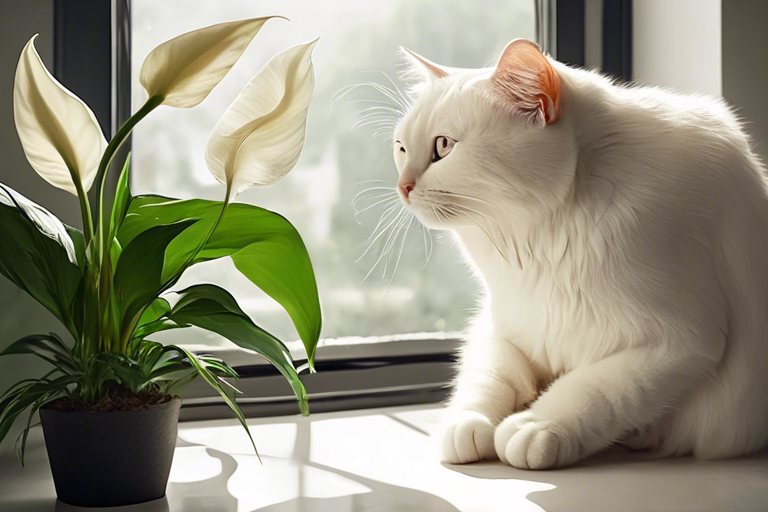Introduction
In our homes, we often strive to create a harmonious environment by incorporating nature’s beauty through plants like peace lilies. These elegant plants with their lush green leaves and delicate white flowers can add a touch of serenity to any space. However, if you are a cat owner, it’s important to be aware that peace lilies can be harmful to our feline friends. The calcium oxalate crystals found in peace lilies can cause a range of symptoms in cats, from discomfort and drooling to vomiting and difficulty swallowing. In this comprehensive guide, we will explore various strategies to keep cats away from peace lilies, ensuring the well-being of both your plants and your beloved pets.
Understanding the Dangers of Peace Lilies for Cats
Peace lilies may appear innocent, but hidden within their beautiful foliage lies a potential threat to our feline companions. The calcium oxalate crystals found in peace lilies are like hidden packs of poison. When cats nibble on these plants out of curiosity, they can experience severe burning sensations, painful swelling, difficulty swallowing, excessive drooling, vomiting, and general discomfort. While peace lilies are not as deadly as some other types of lilies, they can still cause significant distress and, in extreme cases, pose a life-threatening danger to our cats.
Range of Symptoms
When cats come into contact with peace lilies, they may exhibit a range of distressing symptoms. It’s crucial to be able to recognize these signs of toxicity in order to take prompt action. Some common symptoms include:
1. Severe Burning Sensations
The toxins present in peace lilies can cause severe burning and irritation in a cat’s mouth, lips, and tongue. If your cat has ingested parts of a peace lily, they may paw at their mouth or exhibit signs of discomfort.
2. Painful Swelling
The calcium oxalate crystals released from the plant’s cells can lead to painful swelling in a cat’s mouth and throat. This can make it difficult for them to eat, drink, or even breathe properly.
3. Difficulty Swallowing
Due to the discomfort caused by the toxins, cats may struggle to swallow. They may display signs of gagging or retching while attempting to consume food or water.
4. Excessive Drooling
Increased salivation and drooling are common signs of distress in cats that have come into contact with peace lilies. Their mouths may appear excessively wet, and you might notice them constantly licking their lips.
5. Vomiting
In an attempt to rid their bodies of the harmful substances, cats may vomit after ingesting peace lilies. If you notice your cat regurgitating or heaving, it could be a sign of plant toxicity.
6. General Discomfort
Cats that have been exposed to peace lilies may exhibit signs of overall discomfort and unease. They may become lethargic, withdrawn, or exhibit other behavioral changes.
Now that we understand the potential dangers peace lilies pose to our feline friends, let’s explore effective strategies to keep cats away from these plants.
How to Keep Cats Away from Peace Lilies

Image Source: Unsplash
Keeping cats away from peace lilies requires a combination of understanding their instincts and providing alternative options that cater to their needs. With a little creativity and patience, you can create a safe and loving space for both your plants and your furry companions. Here are some strategies to consider:
1. Elevate the Peace Lily
Placing your peace lily on a high surface out of your cat’s reach, such as a tall shelf or a hanging planter, is an effective way to protect both your plant and your cat. By elevating the peace lily, you create a physical barrier that prevents your curious feline from accessing it.
2. Employ Aromatics
Cats have a keen sense of smell, and there are certain scents they dislike. Sprinkling cinnamon or placing citrus peels around the peace lily can help deter feline visitors. These natural aromatics are generally disliked by cats and can discourage them from approaching the plant.
3. Water Spritzing
Cats dislike surprises, especially when it involves water. Installing a motion-activated sprinkler near the peace lily can startle your furry friend and teach them to associate the area around the plant with an unwanted spritz. Over time, this can condition them to stay away from the peace lily.
4. Make a Cat-Friendly Space
Creating an enticing play area for your cat is an excellent way to divert their attention from the peace lily. Fill the space with toys, scratching posts, and cozy spots for them to relax. By providing an alternative space that caters to their needs, you can reduce their curiosity towards the peace lily.
5. Cat-Resistant Barrier
Cats dislike walking on certain textures. Surrounding the peace lily with smooth stones or pinecones can create a natural deterrent. These uncomfortable surfaces discourage cats from venturing close to the plant, protecting both the peace lily and your feline friend.
6. Use Double-Sided Tape
Cats don’t appreciate sticky surfaces. Placing double-sided tape around the pot of the peace lily can discourage them from approaching. The sensation of the sticky tape on their paws will make them think twice before venturing near the plant.
7. Sprinkle Coffee Grounds
The strong smell of used coffee grounds can effectively repel cats. Sprinkling them around the peace lily can create a barrier that cats are reluctant to cross. Remember to refresh the coffee grounds regularly to maintain their effectiveness.
8. Install a Cat Scratch Post
Cats have a natural instinct to scratch, and providing them with a designated scratching post is a great way to redirect their attention from the peace lily. By offering an alternative outlet for their scratching needs, you can prevent them from using the plant as an alternative.
9. Train with Positive Reinforcement
Positive reinforcement is a powerful tool when it comes to training cats. Praise and reward your cat whenever they display behavior that keeps them away from the peace lily. By associating positive experiences with staying away from the plant, you can reinforce good behavior.
10. Use Bubble Wrap
The texture of bubble wrap is disliked by cats. Wrapping it around the pot of the peace lily can create a deterrent that discourages them from approaching. The sensation of the bubble wrap on their paws will make them think twice about venturing towards the plant.
11. Utilize Essential Oils
Some essential oils, such as lemon or lavender, are known to be disliked by cats. Dabbing a small amount near the peace lily can discourage their visits. However, it’s important to note that not all essential oils are safe for cats. Consult with a veterinarian to ensure the oils you use are pet-friendly.
12. Create a Cat-Proof Plant Stand
Investing in a cat-proof plant stand can be an effective way to elevate the peace lily, keeping it safely out of your cat’s sight and reach. There are various cat-proof plant stands available in the market that offer both functionality and aesthetic appeal.
13. Provide an Alternative
Cats are naturally curious creatures, and providing them with an alternative plant to explore can help redirect their attention from the peace lily. Consider offering a pot of cat-friendly plants such as catnip or wheatgrass. These alternative options provide a safe and stimulating chewing experience for your cat.
14. Playful Surprises
Install motion-activated sprinklers or toys near the peace lily to give cats playful surprises if they venture too close. These unexpected interactions can be a fun and effective way to deter them from approaching the plant.
15. Comfort Corner
Create a cozy cat bed or hiding spot near the peace lily to attract your cat’s attention away from the plant. By providing a comfortable and inviting space, you can entice them to spend their time in a more desirable area.
16. Mind Games
Engaging your cat’s mind with puzzle toys and treat dispensers can help keep them mentally stimulated and content. By providing these interactive toys near the peace lily, you can divert their attention and minimize their interest in the plant.
By implementing these strategies, you can create an environment that discourages your cat from approaching the peace lily, ensuring their safety and the longevity of your plant.
Can Peace Lily Kill My Cat?

While peace lilies are not considered as deadly as some other types of lilies, they can still cause significant harm to our feline friends. Ingesting parts of a peace lily can result in severe discomfort and pain for cats. While rare, in extreme cases, the toxins present in peace lilies can pose a life-threatening danger. It’s crucial to take preventive measures and ensure that your cat does not have access to these plants.
What to Do If My Cat Eats a Peace Lily?
If you suspect that your cat has ingested parts of a peace lily, it’s important to take immediate action to ensure their safety and well-being. Follow these steps:
1. Stay Calm
It’s natural to feel anxious, but it’s important to stay calm. Cats are sensitive to their owners’ emotions, and displaying anxiety can cause them to become more stressed.
2. Remove Lily Access
Immediately remove the peace lily from your cat’s reach to prevent further ingestion. Place it in a secure location where your cat cannot access it.
3. Monitor Symptoms
Keep a close eye on your cat for any signs of distress. Look for symptoms such as vomiting, drooling, difficulty breathing, or any other abnormal behavior. If you notice any concerning signs, it’s essential to seek immediate veterinary attention.
4. Don’t Induce Vomiting
While inducing vomiting may be appropriate in some cases of poisoning, it’s important not to attempt this without veterinary guidance. In certain situations, inducing vomiting can worsen the condition or be dangerous for your cat.
5. Call the Vet
Contact your veterinarian immediately and describe the situation. They will provide you with guidance on the next steps to take based on your cat’s specific condition.
6. Seek Emergency Care
If your cat shows severe symptoms, such as difficulty breathing or collapsing, it’s crucial to seek emergency veterinary care without delay. Time is of the essence in these situations, and prompt medical attention can be lifesaving.
7. Provide Water
Offer your cat plenty of fresh water to drink, but avoid forcing them if they are unwilling. Hydration is important, but it’s essential to let your veterinarian determine the appropriate course of action.
8. Don’t Administer Home Remedies
Refrain from giving any home remedies or medications without professional advice. Some remedies may be ineffective or even harmful to your cat’s health. It’s best to follow the guidance of a veterinarian.
9. Keep Cat Calm
Try to keep your cat calm and comfortable while waiting for professional assistance. Create a quiet and secure space for them to rest and minimize any additional stress.
10. Share Information
When you speak to your veterinarian, provide them with as much information as possible. Let them know the variety of the peace lily and the estimated time of ingestion. This information will assist them in determining the appropriate treatment options.
Remember, it’s always better to err on the side of caution when it comes to your cat’s health. If you suspect that your cat has ingested a peace lily or any other potentially toxic plant, seeking veterinary advice is crucial.
Conclusion
In conclusion, living harmoniously with both peace lilies and cats is possible with the right precautions and strategies in place. By understanding the potential dangers of peace lilies for cats and implementing various techniques to keep your furry friends away from these plants, you can create a safe and enjoyable environment for both your plants and your beloved pets. Remember, the well-being of your cat should always be a top priority, and taking preventive measures to protect them from harm is essential.







1 thought on “How to Keep Cats Away from Peace Lily: Best Ways”